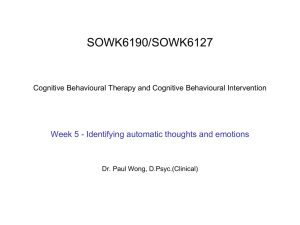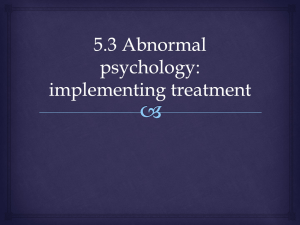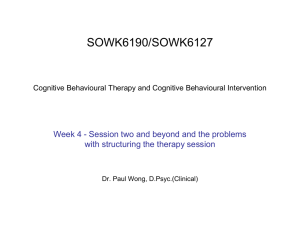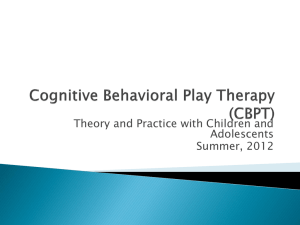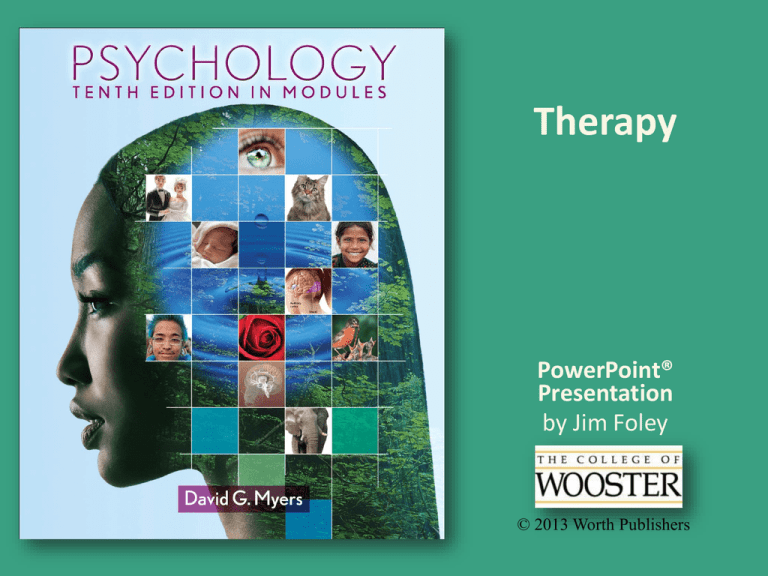
Therapy
PowerPoint®
Presentation
by Jim Foley
© 2013 Worth Publishers
Module 52: The Psychological
Therapies
History of Mental Health Treatment
When people have displayed unusual behaviors rooted
in the mind, these people have often been locked away
or “treated” using old ideas of mental illness.
Old ways of getting rid of
“the evil spirits” include:
beating them out of
people.
bleeding them out.
letting the spirits out
through holes drilled in
the skull.
Reforms in Treatment
This chair was designed to
be an improvement in
medical treatment. It was
meant to have a calming
effect on people with
mania.
Other Reforms in Treatment
Seeing the “insane” as ill
instead of “possessed”
Treating them with
tenderness, not harshness
Housing them in hospitals
rather than locking them
up in asylums
Developing
psychotherapeutic
treatments, medications,
and community supports
to allow life outside
hospitals
Current Forms of Therapy
Psychotherapy:
an interactive
experience with a
trained professional,
working on
understanding and
changing behavior,
thinking, relationships,
and emotions
Biomedical therapy:
the use of medications
and other procedures
acting directly on the
body to reduce the
symptoms of mental
disorders
Combining Therapies
There are various forms of psychotherapy.
An eclectic approach uses
techniques from various forms
of therapy to fit the client’s
problems, strengths, and
preferences.
Medications and psychotherapy
can be used together, and may
help the each other achieve
better reduction in symptoms.
Psychoanalysis
Sigmund Freud (1856-1939) found that
the unusual symptoms of patients
sometimes improved when repressed
inner conflicts and feelings were brought
into conscious awareness.
Psychoanalysis refers
to a set of techniques
for releasing the
tension of repression
and resolving
unconscious inner
conflicts.
Techniques:
Free association: the patient speaks freely about memories,
dreams, feelings
Interpretation: the therapist suggests unconscious
meanings and underlying wishes to help the client gain
insight and release tension
Interpretation in Psychoanalysis
The therapist may see unconscious meaning in resistance,
dreams, and transference.
Resistance:
the therapist notices times when the
patient seems blocked in speaking
about certain subjects
Dreams:
there may be themes or “latent
content” behind the plot of a
patient’s dream
Transference:
the patient may have reactions
toward the therapist that are actually
based on feelings toward someone
from the past
Psychodynamic
Therapy
Less intensive version of
psychoanalysis
Fewer sessions per week
and fewer years
Less theory about sex, id,
and superego
The focus is on improved
self-awareness and insight
into unconscious thoughts
and feelings which may be
rooted in past relationships.
In addition to insight,
therapists suggest changes
in patterns of thinking and
relating to others.
Interpersonal
Therapy
A further extension of
psychoanalysis
The goal is less focused on
insight, and more on
relational behavior change
and symptom relief.
The focus is less on the past,
and more on current
feelings and relationships
including the interaction
with the therapist.
While focusing on several intrusive thoughts that
had been bothering her recently, Jenny was
instructed by her therapist to report any ideas or
memories stimulated by these thoughts. Jenny’s
therapist was making use of a technique known
as:
A.
B.
C.
D.
active listening.
free association.
systematic desensitization.
transference.
Humanistic Therapies
Humanistic psychology (Abraham Maslow and Carl
Rogers) emphasizes the human potential for growth,
self-actualization, and personal fulfillment.
Humanistic therapy
attempts to support
personal growth by
helping people gain
self-awareness and
self-acceptance.
“Client-centered
therapy”
is Carl Rogers’s
name for his
style of
humanistic
therapy.
Client-centered therapists
emphasize the importance of:
A. exploring clients’ childhood relationships
with other family members.
B. interpreting the meaning of clients’
nonverbal behaviors.
C. enabling clients to feel unconditionally
accepted.
D. helping clients identify a hierarchy of
anxiety-arousing experiences.
Style of the ClientCentered Therapist
Being non-directive
Let insight and goals come from the
client, rather than dictating
interpretations.
Being genuine
Be yourself and be truthful; don’t put
on a therapist façade.
Being accepting and showing
unconditional positive regard
Help the client learn to accept
themselves despite any weaknesses.
Being empathetic
Demonstrate careful attention to the
clients’ feelings, partly by reflecting
what you hear the client saying.
Showing Empathy Through
Active Listening
Client-centered therapists
show that they are tuning in
to clients’ feelings and
meanings.
1. Summarize, paraphrase
“So your father wasn’t
around much?”
2. Invite clarification and
elaboration
“When you say ‘anxiety,’
what does that feel like
to you? What is going on
in your body and
thoughts?”
3. Reflect Feelings
“It seems like you are
disappointed; am I
right?”
Behavior Therapy
Sometimes, insight is not helpful to recover
from some mental health problems. The
client might know the right changes to
make, but finds that it’s hard to change
actual behavior.
Behavior therapy uses the principles of
learning, especially classical and operant
conditioning, to help reduce unwanted
responses. These might include behaviors
such as addictions, or emotions such as
panic.
Classical Conditioning Techniques
Counterconditioning
refers to linking new,
positive responses to
previously aversive
stimuli.
If you have been conditioned
to fear stores because you
have had panic attacks there,
you could be led into a store
and then helped with
relaxation exercises. The goal
is to associate stores with
relaxation, a state
incompatible with fear.
Exposure Therapy
A conditioned fear
can worsen when
avoidance of the
feared situation gets
reinforced by a quick
reduction in anxiety.
Guided exposure to
the feared situation
can reverse this
reinforcement by
waiting for anxiety
to subside during
the exposure.
The person can
habituate to (get
used to) the
anxiety itself, and
then the feared
situation.
What mistake is
Professor Gallagher
making here?
Hint: systematic
desensitization
might have been
more effective,
though less
dramatic
Versions of Exposure Therapy
Sometimes, exposure to the feared situation is too anxietyprovoking or impractical. In those cases, you can use:
systematic desensitization. Beginning with a tiny reminder of
the feared situation, keep increasing the exposure intensity as
the person learns to tolerate the previous level.
virtual reality therapy. This involves exposure to simulations,
such as flying (below) or snakes.
Aversive Conditioning
When a person has been conditioned to have a positive
association with a drug...
Aversive conditioning
can associate the drug
with a negative
response.
Operant Conditioning Therapy
Operant conditioning
refers to the shaping of
chosen behavior in
response to the
consequences of the
behavior.
Behavior modification
refers to shaping a client’s
chosen behavior to look
more like a desired
behavior, by making sure
that desired behaviors are
rewarded and problematic
behaviors are unrewarded
or punished.
Applications of Operant
Conditioning
Applied behavioral
analysis/application is used
with nonverbal children with
autism. It rewards behaviors
such as sitting with someone
or making eye contact, and
sometimes punishes selfharming behaviors.
A token economy uses coins,
stars, or other indirect
rewards as “tokens” that can
be collected and traded later
for real rewards.
Cognitive Therapies: Theory
Being depressed and/or anxious involves negative thoughts
and interpretations.
In the cognitive perspective, the cause of depression are
not bad events, but our thoughts about those events.
Cognitive Therapies: Practice
Cognitive therapy
helps people alter
the negative
thinking that
worsens depression
and anxiety.
Therapists might suggest other
thoughts that the clients could
have about their lives, or at
least point out when clients
jump to conclusions that make
them feel worse.
Schools of Cognitive Therapy
Albert Ellis’s rational-emotive behavior therapy
– challenging irrational beliefs and assumptions
Aaron Beck’s cognitive therapy for depression
– correcting cognitive distortions
Donald Meichenbaum’s stress inoculation training
– practicing healthier thinking before facing a stressor,
disappointment, or frustration
Rational-Emotive Behavior Therapy
Albert Ellis showed how depression is worsened by
irrational beliefs. These include depressing assumptions
about the world such as “everyone should like me” or “I
should never do anything wrong.”
Rational-Emotive Behavior Therapy [REBT] helps
people: 1) notice that they are operating on selfdefeating assumptions, and 2) reward themselves for
replacing these assumptions with realistic beliefs. For
example, a more realistic belief might be, “some people
won’t like me, many will have no opinion; it doesn’t
matter.”
Aaron Beck’s Therapy for Depression
Aaron Beck helped people see how their depression was
worsened by errors in thinking such as catastrophizing,
(interpreting current events as signs of the worst
possible outcome). For example:
“Now that I’ve made a mistake in my
lecture, I’ve failed as a professor.
Students can’t take me seriously, and
they can’t learn from me.”
Beck’s style of therapy helps clients notice and
challenge these errors in thinking.
Cognitive Behavioral Therapy
Cognitive behavioral therapy [CBT]
works to change both cognitions and
behaviors that are part of a mental
health disorder.
Using cognitive behavioral therapy, people with OCD are
led to resist the urge to act on their compulsions, as well
as to learn to manage obsessional thinking.
A cognitive therapist would be most
likely to say:
A. “That sounds quite frustrating. It isn’t easy
to be in a situation like that.”
B. “Can you think of a more positive
interpretation of what happened?”
C. “Just say whatever comes to mind, no matter
how trivial or irrelevant it might seem.”
D. “Next time you start to feel anxious, you can
use the relaxation techniques we’ve been
working on.”
A therapist helps Rebecca overcome her fear
of water by getting her to swim in the
family’s backyard pool three times a day for
two consecutive weeks. The therapist’s
approach to helping Rebecca best illustrates:
A.
B.
C.
D.
stress inoculation training.
aversive conditioning.
exposure therapy.
humanistic therapy.
Your therapist asks you to try to
remember your dreams. He also
encourages you to review incidents in
early childhood. Your therapist is most
likely practicing:
A.
B.
C.
D.
Freudian therapy.
cognitive therapy.
behavior therapy.
humanistic therapy.
McKenzie’s therapist believes that active
listening is an extremely important
component of therapy. He is probably a:
A.
B.
C.
D.
psychoanalyst.
cognitive therapist.
behavior therapist.
client-centered therapist.
Family Therapy
Having a session with the whole family, at
home or in the office, allows the therapist to
work on the family system, that is, the family’s
patterns of alliances, authority, and
communication.
A related modality is couples/marital therapy.
Group Therapy
Group therapy assembles about six to nine
people with related needs into a group, facilitated
by a therapist, to work on therapeutic goals
together. The benefits include:
less cost per person.
more interaction, feedback, and support.
clients realize others share their problems and
they are not alone.
Self-Help Groups Self-help groups are led by group members
instead of a therapist.
They can be much larger than group therapy,
with less interaction.
The focus is more on support rather than on
working on goals during the group session.



